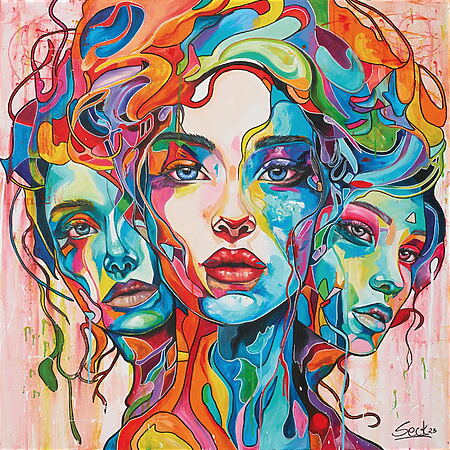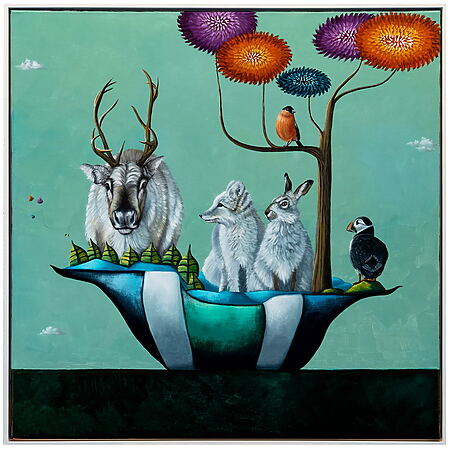The kitchen is much more than just a place of food preparation. It can become a stage for culinary works of art, where the aesthetics of the dishes are as important as its taste.
This art form, known as food art , is enjoying growing popularity and offers countless opportunities to combine creativity and culinary skills. In this article we illuminate the different facets of the Food Art and give practical tips on how to transform everyday dishes into visual masterpieces.
The basics of the Food Art
Food Art is the art of arranging food and decorating so that they appear visually appealing and artistic. Colors, shapes and textures play a crucial role here. A simple example is to serve fruit and vegetables in the form of flowers or other patterns on a plate.
More complex techniques include carving vegetables - here you will find unique kitchen knives from Tsume - or fruit and the use of sauces and spices to create works of art on the plate.
From cave paintings via EAT-Art to Food Art
Essen was used in prehistoric times to create artistic works: Cave paintings were created by using natural pigments from plants and animals.
Artistic representations in ancient Egypt showed numerous representations of bread, grain and other foods. In Roman art, too, numerous frescoes, mosaics and sculptures can be found that map fruits, offerings and solids. Medieval manuscripts contain detailed illustrations of meals in various social contexts. The motive of the last sacrament was particularly popular and was often interpreted artistically.
In the Renaissance, Giuseppe Arcimboldo created fascinating portraits of fruit and vegetables. Detailed still lifes from the golden age of the Netherlands show breakfast tables, seafood and exotic delicacies. Fruits and vegetables were also shown as erotic symbols .

Even in later arts, still lifes enjoyed fruits very popular. One of the masters of this art was Paul Cézanne , whose works capture the beauty and diversity of nature in an impressive way.

Filippo Tommaso Marinetti was the pioneer of a new art direction within the modern age , which regarded the preparation and consumption of food as an artistic expression. With other artists, he founded the avant -garde futuristic movement in Milan in 1909, which was inspired by the industrial age and covered mechanical elements such as cars, planes, production processes and urban planning.
The futurists saw cooking and eating as an essential part of everyday life and sought to put this into the focus of their visionary ideals. In 1932 Marinetti published the "Futuristic cuisine" , which contained much more than just recipes; Rather, it acted as a kind of manifesto.
He viewed the preparation and enjoyment of dishes as part of a new worldview, in which hospitality became an avant -garde performance. In the book, the essential elements were described for a perfect meal: originality, harmony, sculptural shapes, fragrance, music between the corridors, a combination of different dishes and canapés with different flavors.
The cook should use high-tech devices and avoid controversial political issues when eating, which should be set up in such a way that no cutlery was needed. Marinetti's ideas could not guess the important role of eating almost a century later in art.
Contemporary artists today use food for political (especially feminist), economic and social messages. They open restaurants as art projects and staging performances in which food is prepared and served in galleries. They also create artistic sculptures from edible materials such as chocolate and cheese. Although Marinetti might be surprised by this development, some artists even consider food to be a radical departure from a future consideration full of obsessions.
During the era of pop art, Essen became a symbol of society. Wayne Thiebaud painted rows of cakes and cakes in bright pastel colors, which reminded of advertising and children's toys. His arrangements, which seemed more like presentations in a diner than such as homely elements of private life, reflected a society in which lush desserts represented the American abundance.
At the same time, artists like Daniel Spoerri using real foods as art material and created EAT-Art .
He is one of the most prominent artists in object art, was largely involved in the foundation of the artist group Nouveau Réalisme and is considered the creator of EAT-Art.
In 1970, the Sardonian Swiss-German artist Dieter Roth a piece entitled "Staple Cheese (A Race)" , which consisted of 37 suitcases filled with cheese and other pressed suitcases and was hung on the walls, with the intention that they would drip or "run" on the floor.
Shortly after the opening of the exhibition in Los Angeles, an unbearable stench spread. The gallery was flooded by maggots and flies, and the health inspectors threatened to close. The artist explained that the insects were actually his target audience.
The feminist artists of the late 1960s and early 1970s looked at the American relationship with the food with regard to the constraints that were imposed on women. Feminists claimed that the personal - including the most everyday aspects of everyday life - was political.
Miriam Schapiro and Judy Chicago rented an empty house with 17 rooms in Los Angeles, which was to be demolished, and turned it into a huge art installation. Schapiro and other artists created an immersive installation in the dining room that followed the process, follow the girl when decorating doll houses.
Her project, both a performance and an installation, condemned the double standards of society - inequality in the expectations and opportunities of men and women. Later, feminist artists such as Elizabeth Murray in works such as "Kitchen Painting" (1985) suggested that women are strong enough to get along with the secular and home by a clumpy spoon that is bound to a figure that is leading a kitchen, the image level and the viewer seem to be confronted.
Inspirations of famous artists and original creations
A great starting point for Food Art is inspiration by famous works of art. Imagine making a breakfast in such a way that it is reminiscent of Van Gogh's "Sternnacht" , or a dessert that reflects the colors and shapes of Mondrian's geometric paintings.
Such interpretations require a good eye for details and a feeling for aesthetics. Start with simple patterns and work on more complex designs while improving your skills.
You can find inspiration and recommendations for your personal food art creations in our Pinterest collection
(To display the Pinterest Board you must have approved the cookies)
Practical tips for aesthetic presentation
The aesthetic presentation of dishes is an art that every dish can make a visual experience. With some simple but effective techniques, you can not only upgrade your dishes in terms of taste, but also visually.
Here are some practical tips on how to use colors, textures and shapes to transform their culinary creations into real works of art.
- Color play: Use the natural variety of colors of food. Combine contrasting colors such as red tomatoes with green basil or yellow peppers with purple carrots. Colors should not only appear aesthetic, but also appetizing.
- Textures and shapes: Experiment with different textures and shapes. Cut vegetables into different shapes or use cookie cutter to create interesting designs. Combine crispy and soft elements to improve the visual and taste experience.
- Plattentechnik: The way a dish is arranged on the plate can make a big difference. Use the plate as a canvas and place the elements so that you look harmonious. Leave enough space so that the eye can perceive each element without being overloaded.
- Edible decorations: petals, edible gold flakes or microcracy can upgrade dishes and give them a special note. Make sure that all decorations are edible and taste.
- Saucen and dressings: Use sauces and dressings to put patterns and accents on the plates. A simple chocolate sauces on a dessert plate or a ring made of balsamic reduction on a salad plate can be visually impressive.
Step-by-step instructions: an artistic dessert
An example of an artistic dessert could be a "fruit tart mandala" :
- Base: Start with a shortcrust pastry and a layer of vanilla cream.
- Design: Cut different fruits (e.g. strawberries, kiwi, blueberries, mango) into thin slices.
- Arrangement: Place the fruits concentrically in patterns, starting from the center to the outside. Make sure that the colors are alternately and symmetrically arranged.
- Finish: shine the mandala with a slight apricot gelee coating to keep the fruits fresh and shiny.
Final thoughts
The art of the Food Presentation is a wonderful way to live out your creativity in the kitchen and impress your guests. With a little practice and inspiration, you can transform everyday meals into real works of art. Remember that the aesthetics should not go at the expense of the taste.
A harmonious connection between taste and appearance makes the true art of cooking. Have fun experimenting and creating your own culinary masterpieces!

Owner and managing director of Kunstplaza. Publicist, editor and passionate blogger in the field of art, design and creativity since 2011. Successful conclusion in web design as part of a university degree (2008). Further development of creativity techniques through courses in free drawing, expression painting and theatre/acting. Profound knowledge of the art market through many years of journalistic research and numerous collaborations with actors/institutions from art and culture.


















